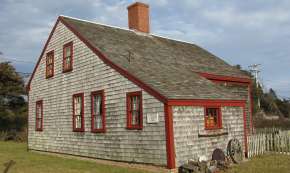Caleb Nickerson House Museum

Welcome to the Caleb Nickerson House Museum. The building was built by Caleb and Priscilla Eldredge Nickerson in the 1820s, the same period as Olde Sturbridge Village in Central Massachusetts. The home spent 180 years at 230 Stage Harbor Road in the southern area of Chatham. In 2002 in order to satisfy estate taxes, it was sold but the buyer was only interested in the land. Instead of demolition, the buyer offered the home to the Nickerson Family Association, but the offer was contingent on the Association moving the home quickly. With great support from the Town of Chatham, through the Community Preservation Act, and generous contributions from our members, the Association was able to move the home to its current site a few hundred feet from the 1660s homestead of the original Chatham Nickersons.
Relocation of the home took place in October 2003. It was transported to Stage Harbor Landing by truck where a crane hoisted it onto a barge. The barge had to travel a circuitous route out beyond the Chatham Bar and South Monomoy Island into the Atlantic and then back through the Chatham Cut near Lighthouse Beach and finally to Ryder’s Cove where it was offloaded to a truck for its final journey to where you see it now.
Thanks significantly to the work and generosity of Association Past President Edmond Nickerson, the structure sits on a new foundation and the interior was completely redecorated to what it might have looked like in the 1820s. It has modern electricity, heat and plumbing that are carefully hidden from the view of a casual observer.
The Caleb Nickerson House Museum is a “working museum”. That is, it is available for touring groups, but many of the public events during the year involve using the fireplaces for cooking and classes are held periodically at the museum. The early American garden surrounding the home is used for classes. The fruits and vegetables from the garden are used for cooking events at the museum. A loom on the second floor is periodically in use to demonstrate how people made clothing in the early 19th century.
 Back to Nickerson Homestead
Back to Nickerson Homestead